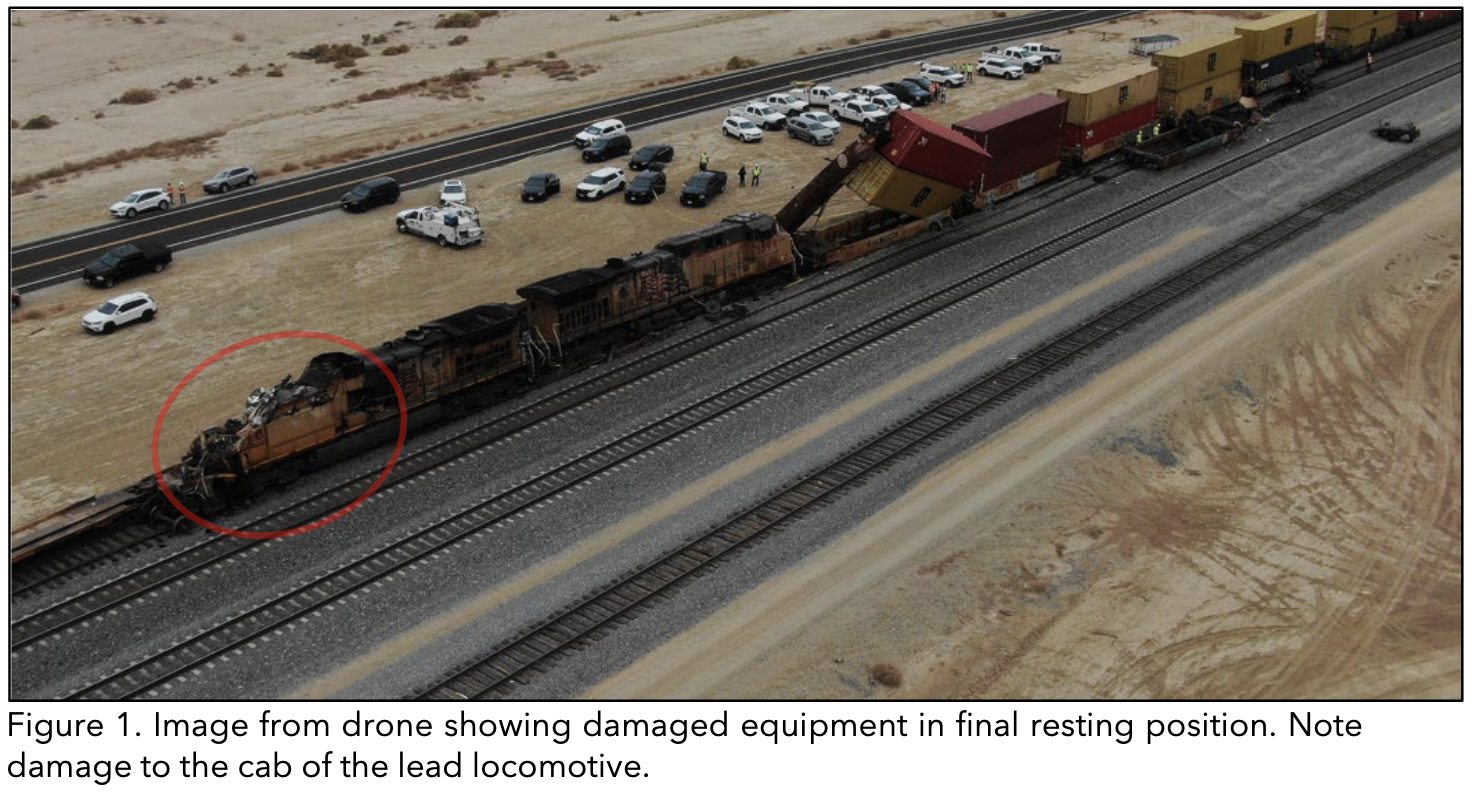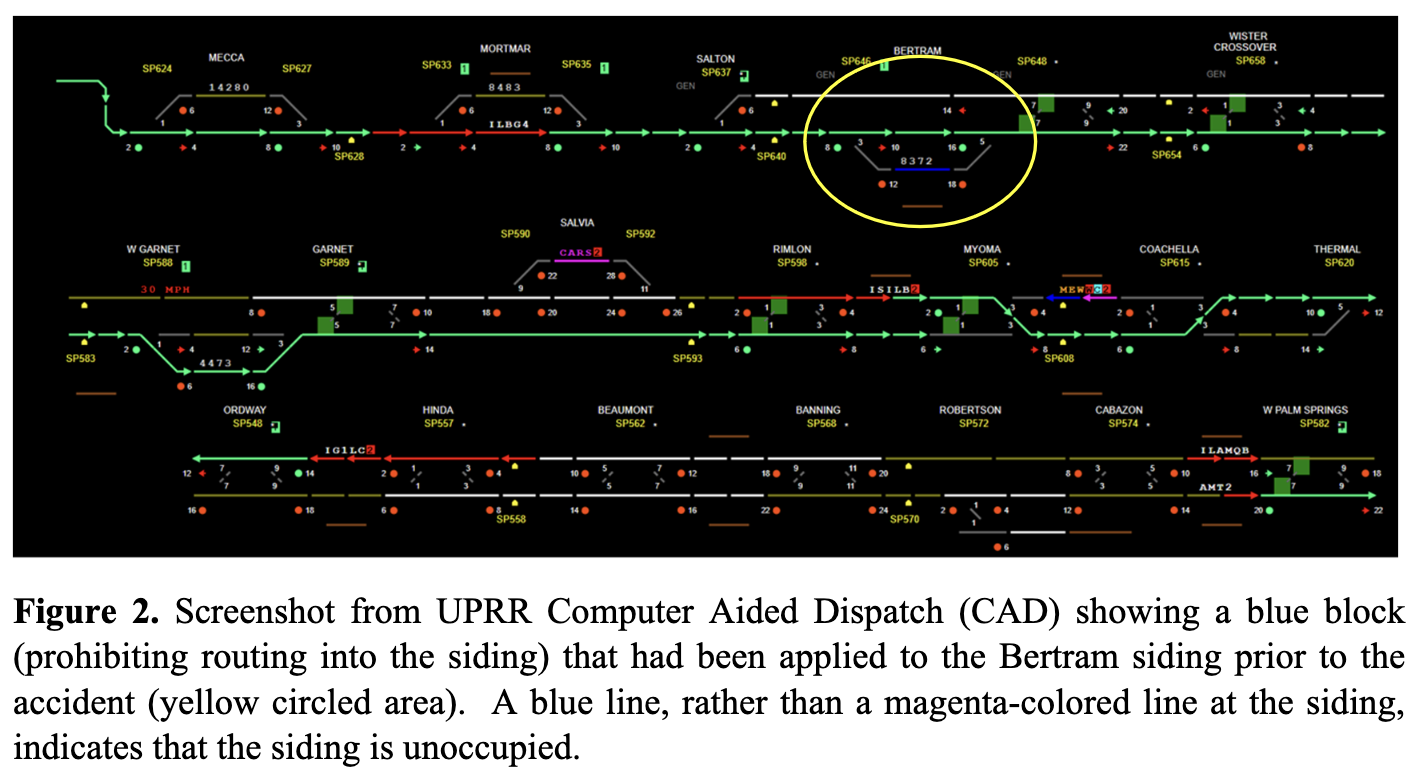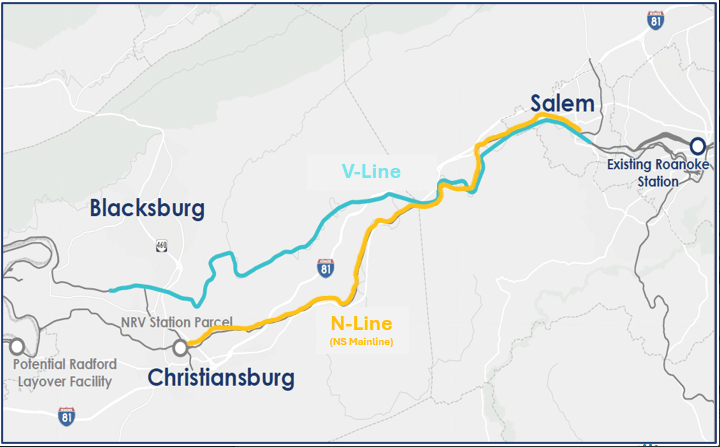
WASHINGTON – The track circuit for a California siding where Union Pacific had stored empty well cars for more than eight months shifted between occupied and unoccupied nearly two dozen times in the nine hours before a stack train was routed into the siding with fatal results [see “UP train in fatal collision hit cars stored on siding since December 2021,” News Wire, Sept. 29, 2022].
At the time of the 2:41 a.m. accident on Sept. 8, 2022, the track circuit showed Bertram siding was unoccupied — but it actually held 74 well cars that had been parked on the siding since Dec. 29, 2021, according to documents the National Transportation Safety Board released on Friday as part of its investigation of the Sunset Route wreck that killed two UP crewmen.
NTSB investigators found a significant amount of rust on the rails of Bertram siding as well as on the wheels of the parked well cars, and noted that rust on rails and wheels “are known to create poor shunting conditions.” The siding’s location within 1,700 feet of the Salton Sea, which has unusually high salt levels, exacerbates rust buildup, the NTSB said.
The first time the Bertram track circuit became energized as unoccupied with the 74 cars present was on Aug. 29, 2022 — the same day a dispatcher removed the track tag that was in place for the siding, the NTSB said. UP logs documented 56 times that track circuits intermittently reported the siding as unoccupied between Aug. 29 and Sept. 7.
Westbound train ISILB5 — running from Santa Teresa, N.M., to Long Beach, Calif. — passed Bertram siding, on UP’s Yuma Subdivision, around 9 p.m. But the crew was looking ahead and did not notice cars in the siding. Some 40 miles later, the train stopped at Myoma, Calif., for helper locomotives to couple on to the rear of the 122-car stack train.
When the train reached West Palm Springs, Calif., the dispatcher in Omaha, Neb., radioed the conductor of ISILB5 to inform him that Long Beach could not take the train. The dispatcher ordered the crew to operate the train to Bertram siding, where it would be parked.

“The conductor told the dispatcher that he believed there were cars in Bertram siding,” the NTSB report says. “The dispatcher looked at his CAD screen, and saw only a dark blue line at the siding (indicating that there was a block on it) but did not see an indication that any cars or equipment were occupying the siding. He told the conductor that his CAD screen was showing the siding to be clear. There was no other discussion about the occupancy of Bertram siding.”
The UP dispatching system would have depicted the siding as magenta if the track circuit showed the siding was occupied or if a dispatcher’s track tag had been applied.
The eastbound ISILB5 — with its helper locomotives and crew in the lead — entered Bertram siding at 2:41:16. The parked well cars became visible about 8 seconds later. The train collided with the standing cars at about 28 mph, the NTSB said.
The surviving crew members in the locomotives at the rear of the train reported to the dispatcher that the train was in emergency and that there was no response from the helper crew aboard the lead locomotive.
Amtrak train No. 2, the eastbound Sunset Limited, was operating in the area at the time and gave the conductor a ride to the derailment scene. Members of the Amtrak crew assisted in locating the helper crew. The engineer’s body was found in the cab, while the conductor’s body was found beneath the train.
“The front of the locomotive looked like a soda can that got dropped into a blender,” the Amtrak engineer said.
The NTSB’s re-enactments of the events leading up to the collision found that cars in the siding would have been visible to the crew when the westbound ISILB5 passed Bertram, but that the helper crew leading the train eastbound would have had only 8.5 seconds to see the cars ahead — well past the signal that lined the train into the siding.
The NTSB documents note that UP Signal Test and Standards rules require cars in storage for more than 10 days to be protected by derails and all switches leading to the track to be spiked or clamped and tagged to remove them from service.
Following the wreck, UP conducted a systemwide dispatcher safety stand-down and reviewed rules and processes for removing protection for standing equipment, the NTSB said. The railroad also conducted a systemwide review of sidings with cars in storage for an extended period and made permanent changes to the signals at Bertram so that they would display a restricting signal for trains entering the siding.
The NTSB has yet to issue a final report that will include contributing factors that likely caused the wreck, as well as recommendations to prevent future incidents.














Sloppy indifference got 2 men killed. Vena has got bigger problems than unhappy customers.
1. Condr report of cars on siding Bertram should’ve triggered “doubt and uncertainty” in mind of train dispr. Why did this not happen?
2. Rule requires when siding is blocked with cars, switch blocks be applied to dual-control switches and remain applied until cars are removed. TRACK BULLETIN MUST ALSO BE ISSUED ADVISING OF SIDING BLOCKED WITH CARS. Protective track label must be applied to siding giving reason for protection. Why were these three steps not taken and remain in effect for the several months that cars occupied siding at Bertram.
3. Train dispatchers should have been issuing advice to their relieving train dispatchers in written transfer that “Siding Bertram in blocked with cars”. Why was this not done?
4. This bears similarity to collision at Devine, Texas, in June, 1997, as a result of dispr failure to properly protect movements in dark TWC that resulted in four deaths.
5. Dispr on duty should never have been able to display a permissive signal for movement into siding at Bertram for train movement had established rules and policies been followed and that would’ve been practical only with effective training, efficiency testing, and knowledgeable supervision by experienced train dispatchers and not personnel from other departments without any knowledge of train dispatcher work practices and rules.
1. Condr report of cars on siding Bertram should’ve triggered “doubt and uncertainty” in mind of train dispr. Why did this not happen?
2. Rule requires when siding is blocked with cars, switch blocks be applied to dual-control switches and remain applied until cars are removed. TRACK BULLETIN MUST ALSO BE ISSUED ADVISING OF SIDING BLOCKED WITH CARS. Protective track label must be applied to siding giving reason for protection. Why were these three steps not taken and remain in effect for the several months that cars occupied siding at Bertram.
3. Train dispatchers should have been issuing advice to their relieving train dispatchers in written transfer that “Siding Bertram in blocked with cars”. Why was this not done?
4. This bears similarity to collision at Devine, Texas, in June, 1997, as a result of dispr failure to properly protect movements in dark TWC that resulted in four deaths.
5. Dispr on duty should never have been able to display a permissive signal for movement into siding at Bertram for train movement had established rules and policies been followed and that would’ve been practical only with effective training, efficiency testing, and knowledge supervision by experienced train dispatchers and not personnel from other departments without any knowledge of train dispatcher work practices and rules.
Conductor “eye witness” should have taken president over a dispatcher thousands of miles away.
Another factor–dispatcher thousands of miles away from the scene–may not know the railroad.
So here is another example of something small in detail being overlooked with devastating consequences.
“UP Signal Test and Standards rules require cars in storage for more than 10 days to be protected by derails and all switches leading to the track to be spiked or clamped and tagged to remove them from service.”
“Union Pacific had stored empty well cars for more than eight months”
I would have hoped that with an intermittent fault of 56 occasions someone would have investigated.
Then the conductor who knows the district telling a dispatcher in Omaha he believes the siding is occupied and it’s brushed aside.
Classic example of many small failures adding up to fatalities.
No wonder the FRA is breathing down their neck.
Exactly